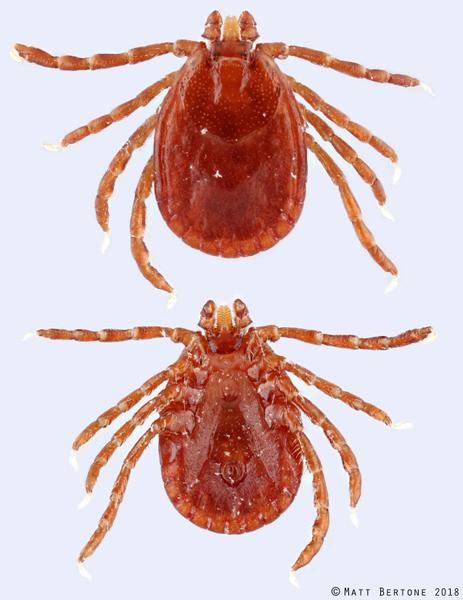Asian Longhorned Tick in Madison County
go.ncsu.edu/readext?946694
en Español / em Português
El inglés es el idioma de control de esta página. En la medida en que haya algún conflicto entre la traducción al inglés y la traducción, el inglés prevalece.
Al hacer clic en el enlace de traducción se activa un servicio de traducción gratuito para convertir la página al español. Al igual que con cualquier traducción por Internet, la conversión no es sensible al contexto y puede que no traduzca el texto en su significado original. NC State Extension no garantiza la exactitud del texto traducido. Por favor, tenga en cuenta que algunas aplicaciones y/o servicios pueden no funcionar como se espera cuando se traducen.
Português
Inglês é o idioma de controle desta página. Na medida que haja algum conflito entre o texto original em Inglês e a tradução, o Inglês prevalece.
Ao clicar no link de tradução, um serviço gratuito de tradução será ativado para converter a página para o Português. Como em qualquer tradução pela internet, a conversão não é sensivel ao contexto e pode não ocorrer a tradução para o significado orginal. O serviço de Extensão da Carolina do Norte (NC State Extension) não garante a exatidão do texto traduzido. Por favor, observe que algumas funções ou serviços podem não funcionar como esperado após a tradução.
English
English is the controlling language of this page. To the extent there is any conflict between the English text and the translation, English controls.
Clicking on the translation link activates a free translation service to convert the page to Spanish. As with any Internet translation, the conversion is not context-sensitive and may not translate the text to its original meaning. NC State Extension does not guarantee the accuracy of the translated text. Please note that some applications and/or services may not function as expected when translated.
Collapse ▲There has been a new tick running rampant through Madison County, North Carolina.
The Asian Longhorned Tick (Haemaphysalis longicornis), often abbreviated to ALT, is an invasive tick species that is now causing problems up and down the eastern seaboard of the United States. This tick originated in China, Japan, and Korea, tough it was later introduced to New Zealand, Australia, and several different Pacific Islands. They reached the United States in 2010, beginning in New Jersey before moving into 17 different states, including North Carolina. As of May 2022, it has been discovered in 22 different North Carolina counties, including Madison County, as well as surrounding counties such as Buncombe and Haywood.
These ticks are unique in their biology in a way that makes them more potentially dangerous to livestock, pets, and potentially people in the United States. These ticks (pictured below) can reproduce asexually through a process known as parthenogenesis, which can be the easiest explained as a female reproducing without the need of a male, where the female tick creates eggs with full copies of her own DNA rather than needing a male tick to contribute half of the DNA. All of the ALT identified in the United States reproduce using this asexual method, meaning that each female tick can lay about 900-3,300 eggs at once, and those eggs contains only female ticks. This means that the population of these ticks can increase at massively fast rates.

Asian Longhorned Tick photo taken by Matt Bertone – upper tick visual of the back, lower tick visual of belly
Known hosts for the ALT include domestic cats, dogs, cattle, goats, horses, and sheep, as well as many different wild species, contributing to their spread around the county, and humans and occasionally birds. Heavy infestations of the ALT can cause severe blood loss, poor growth and development, and can contribute to the spread of diseases from animal to animal. Though these ticks are not capable of transmitting Lyme disease, they are a vector for several other dangerous pathogens such as Anaplasmosa, Theileria, Rickettsia, Babesia, Borrelia, and Ehrlichia, all of which and more can cause disease in both humans and animals. There has also been research shown from other countries such as Japan, where the ALT is native, that shows that bites from the ALT could cause alpha-gal syndrome, which can create a severe red meat allergy in humans.
As frightening as all of this may sound, there is hope! You can protect yourself from these nasty little ticks by using insect repellents and spraying your clothes with an approved permethrin repellent. You can protect your pets by contacting your veterinarian to determine which approved tick control products for pets are best for your situation.If you’re concerned your livestock may be infested, examine their ears, dewlap, udder, and around the perianal area, especially if you’re already bringing the animals in for routine procedures such as ear tagging, vaccinations, and even AI or pregnancy checks. You can prevent these problems such as blood los and loss of gains in your livestock by treating them with pyrethroid sprays or pour-on insecticides to help protect them, as well as setting up backrubbers and dust bags that use tick-killing products (known as acaracides) where livestock can do self treatments if these rubbers and dust bags are maintained regularly. You can find a list of available pesticide products that could be used to protect your livestock can be found in the 2023 North Carolina Agricultural Chemicals Manual.
For more information, visit NC State’s article, or contact Peyton Duckett at (828) 649-2411, or peyton_duckett@ncsu.edu.



